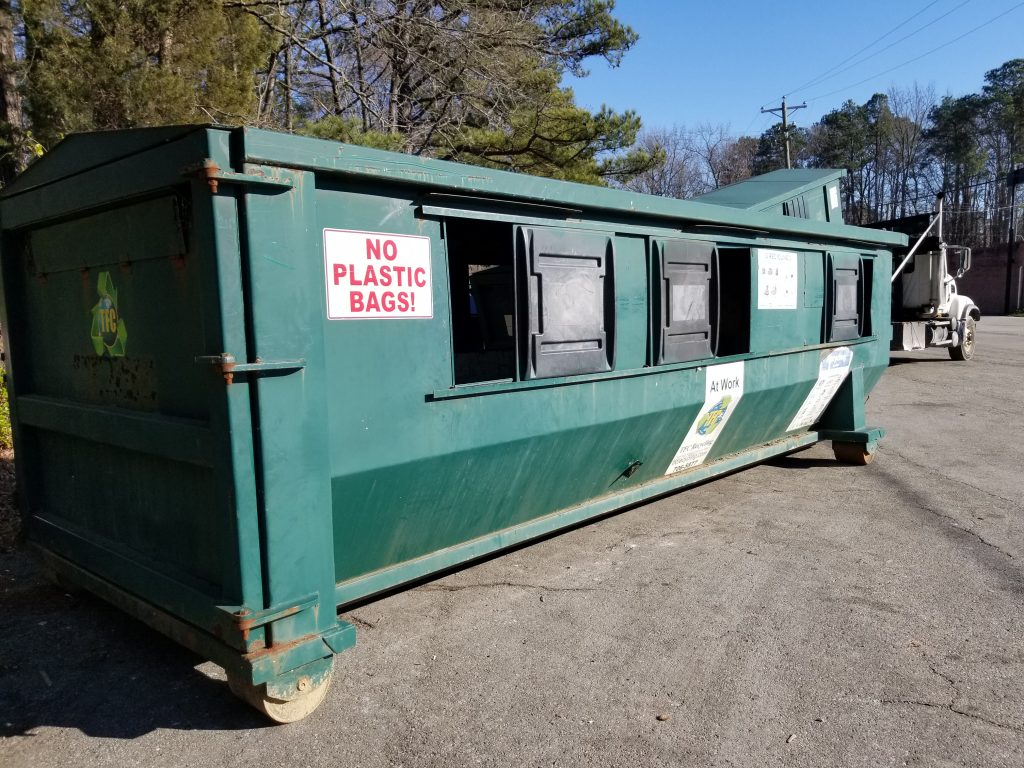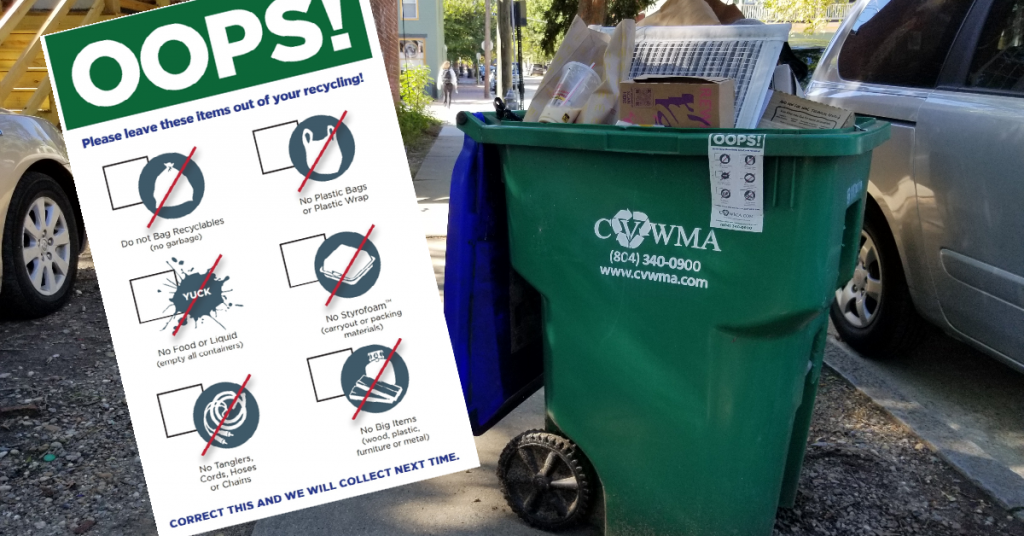Richmond Recycles: What I’ve Learned as a CVWMA Board Member
October 6, 2023 |
Elizabeth Hall represents the City of Richmond on the CVWMA Board of Directors. This article was part of a series that appeared on RVAHub.
Have you ever wondered how your local recycling authority works, how it’s set up or why you can’t recycle certain materials? Well, consider today’s feature a CVWMA 101 course.
I’ve always been down with the circular economy. I had to be. Growing up, my dad was the household trash monitor — nothing went into the bin that could be repaired, reused, or repurposed. Food waste became compost for the vegetable garden; used jars stored seeds and supplies in the garage; and, finally, anything that could be commercially recycled was rinsed and set aside. Part of the reason may have been because back then, where I grew up, dad had to haul the weekly trash 25 miles to the county dump and pay per pound (but that’s another story). Unlike trash disposal, recycling dropoff was free for residents. And the good news is, that’s still true today here in Richmond.
After I grew up, I stayed interested in waste reduction — working in my early career for environmental trade publications and organizing litter cleanup and park beautification events in my neighborhood. Later, as I settled into my Richmond home, I started looking for more local environmental volunteer opportunities. So, when I learned about Richmond’s Citizen Boards, I sent in an application to represent the City on the regional recycling and solid waste board. I joined the Central Virginia Waste Management Authority (CVWMA) board in November 2021, and here’s a bit of what I’ve learned so far:
Who Manages Richmond Recycling: CVWMA in a nutshell
CVWMA was formed in 1990 under a state order to raise the regional recycling rate to a 25% minimum and to do an overall better job managing our waste. A total of 13 jurisdictions are members of CVWMA, with the largest being Henrico County, Chesterfield County, and the City of Richmond. The governing board is composed of volunteers — some are citizen residents (like me), and others are city and county employees (like my fellow board member, who works for the Department of Public Works).
The board reviews and approves CVWMA’s annual operating budget, program statistics, and vendor contracts, as well as provides assistance in advisory roles and long-term strategic planning. The Authority maintains a small but mighty paid staff that provides management, analysis, communications, and customer service. Their core responsibilities are to negotiate, manage, monitor, and execute waste and recycling contracts with vendors as they operate within the 13 localities.
CVWMA provides recycling services in some form for all of its localities and today boasts a nearly 60% recycling rate across its jurisdictions — far exceeding the original 25% target it set out to achieve.
CVWMA provides customized waste management and diversion services to each locality based on their government’s needs. In Richmond, the most visible and enduring programs are curbside recycling and drop-off recycling.
The drop-off sites accept all the same materials as the curbside recycling program and are a great option for those ineligible for the curbside program, such as residents of larger multi-unit apartment buildings.
Recycling drop-off operates in collaboration with the Richmond Department of Public Works at the following city locations:
- The Parker Field Annex, 1700 Robin Hood Road, Sunday-Saturday, 7 a.m.-dusk
- East Richmond Road Convenience Center, 3800 E. Richmond Road, Monday-Friday, 7 a.m.-3:30 p.m.; Saturday, 8:30 a.m.-2 p.m. City Residents Only.
- Southside Transfer Station, 3520 N. Hopkins Road, Monday-Friday, 7 a.m.-4:30 p.m.; Saturday, 8:30 a.m.-2 p.m. City Residents Only.
- Stratford Hill Shopping Center, 6788 Forest Hill Avenue, all hours
How it works: CVWMA in Our Neighborhood
In 2015, Richmond City and CVWMA rolled out 95-gallon carts for single-family homes and apartments up to four units. The recycling bins have blue lids, which distinguishes them from DPW’s all-green solid waste bins. Remember, your recycling and trash collection services are not operated by the same entities. The City manages your trash bins and bulk & brush collections, while CVWMA oversees your household recycling. The Authority’s logo, website, and customer service phone number are printed on the side of each cart, so you can tell it apart from the trash can and know who to contact if you have questions or requests.
Unlike trash collection, which comes every week, the recycling collection happens every other week on the same day. The Authority designates these as “red” or “blue” collection weeks, but you don’t have to memorize your color. CVWMA provides address-specific calendars and an emailed recycling collection reminder the day before your scheduled pickup on its web tool. Plug in your address and sign up in order to receive a reminder.
The Authority contracts with TFC Recycling to pick up and process the curbside and drop-off recycling. That means that the trucks and drivers you see picking up recycling are owned and operated by TFC, not CVWMA, even though the carts have the Authority’s logo on them.
Every eligible residence in the City is automatically enrolled in the curbside recycling program, and the fee is rolled into your utility bill along with water and trash. Residents currently pay a monthly $2.99 fee for recycling services. That’s a tiny fraction of the total solid waste charge (check your bill to see the difference).
Despite its accessibility, Richmond’s curbside recycling program faces some typical urban challenges. Its ubiquitous alleys, multi-unit households, and neighborhood businesses pose a city-specific set of challenges to recycling collectors. For one, TFC Recycling cannot use the same trucks in Richmond that it deploys in the other localities because they’re too wide for Richmond’s alleys. To navigate the city’s confined spaces, the company has to dispatch smaller trucks and even some crews on foot.
Richmond also has a higher concentration of residents, more apartments, and more frequent residential turnover than the counties, thanks in part to the high student population. More people + more turnover = more items in the alley, both recyclable and not. CVWMA’s carts are easily overwhelmed during move-in/move-out seasons and can often become filled with non-recyclable items, including furniture and trash.
Recycle Right: How to Help Cap Contamination
CVWMA provides a wealth of online guidance about what you can and can’t recycle. Items should be rinsed clean and free of food waste. Otherwise, they can contaminate a whole batch of recycling. This reference guide shows what materials can be sorted and processed at the TFC facility:
If you’re still not sure, use CVWMA’s Recycling Wizard tool to find the right recycling process for your item. And because it’s always good to review, here are the top 5 Don’ts for your household recycling:
- Don’t include items with food on them.
- Don’t bag your recycling in plastic bags.
- Don’t recycle plastic bags in curbside containers or city dropoffs (many grocery stores provide plastic bag recycling).
- Don’t include Styrofoam, shredded paper, batteries, hoses, or cords (these items can’t be processed at the MRF).
- Don’t include bulky, rigid plastic — like coat hangers, storage bins, and laundry baskets — or yard waste.
How can you help reduce recycling contamination? Communication and education are key. Make sure you’re clear on how to recycle right and share resources from CVWMA with your neighbors and community. If you live in an apartment that provides recycling pickup, consider posting information in a central location so other residents can also learn what items cause recycling contamination.
If your or your neighbor’s cart is contaminated, you may see an “Oops!” sticker across the lid explaining what constitutes contaminating materials and what must move out of the recycling cart and into the trash. The recycling trucks cannot empty contaminated bins. So, those bins will be skipped during collection and will stay full until the trash materials are removed. If you’re noticing contamination in your cart, consider bringing it inside of a fenced area or closer to your residence to try to cut down on contamination from alley passersby.
If you see contaminated recycling bins in your neighborhood or alley that aren’t being addressed, report the issue to CVWMA by emailing CustomerService@cvwma.com. Include the street address and unique ID number printed on the side of each cart. The Authority will work with DPW to have the recycling bins emptied during the city’s regular solid waste collection. If the bins are contaminated, all of the material will have to go into the trash, including any recyclable items that may be mixed in.
Tags: circular economy, city of richmond, cvwma, elizabeth hall, recycling, regional recycling rate, virginia





